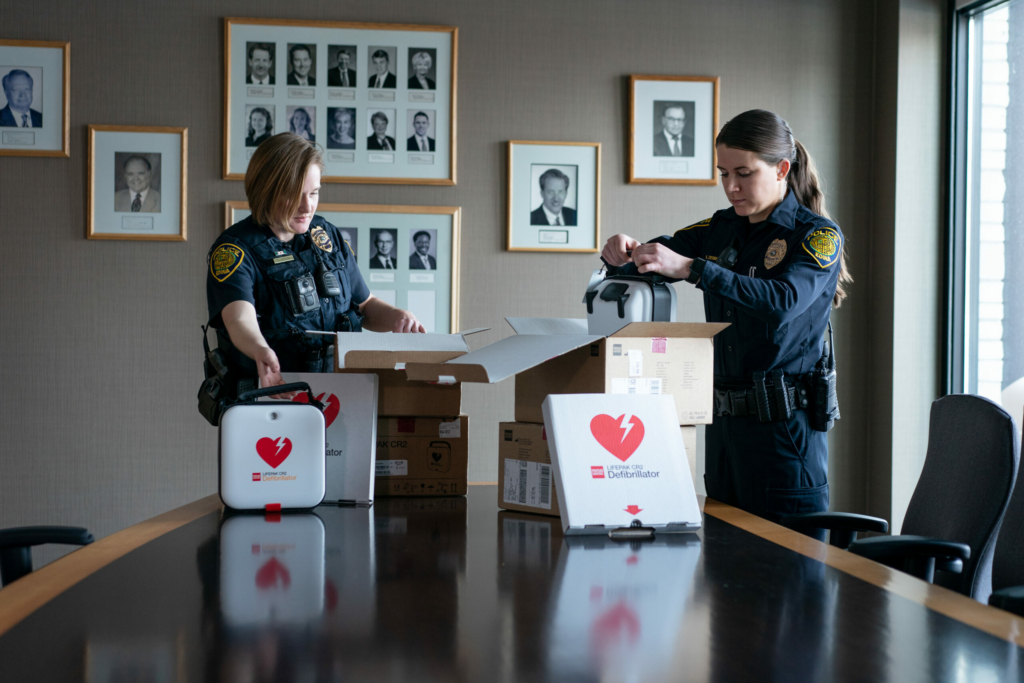
In 2019, the Helmsley Rural Healthcare Program launched the First Responder AED Initiative. Since then, the Program has awarded more than $60 million to provide nearly 25,000 automatic external defibrillators (AEDs) to local law enforcement agencies in Iowa, Minnesota, Montana, Nebraska, Nevada, North Dakota, South Dakota, and Wyoming. This initiative is filling a critical gap in rural healthcare resources by equipping law enforcement officers – who are often the first to arrive on the scene of a medical emergency – with AEDs to provide rapid cardiac arrest response.
Wayne Booze, Program Officer for the Helmsley Charitable Trust’s Rural Healthcare Program, discusses the initiative, its lifesaving impact in rural America, and what Helmsley aims to accomplish next.
Time is the enemy in sudden cardiac arrest. For every minute that goes by without CPR and defibrillation, the chance of survival drops 10 percent. In rural America, emergency medical services (EMS) are doing everything they can to keep their communities safe and healthy, but the average response time is more than 14 minutes because they have to cover greater distances when responding to a medical emergency.
Law enforcement officers can arrive at the scene much faster than EMS because they are already on patrol out in communities and, when equipped with the proper resources and training, can intervene and give patients a better chance of survival. This was the thinking behind our First Responder AED Initiative. By placing valuable technology in the hands of rural law enforcement officers, we are improving the level of care available in rural communities.
Our grantees experience firsthand just how important these devices are. Since the First Responder AED Initiative started, Helmsley devices have been used to save more than 100 lives. This success is getting noticed and we regularly receive calls from different law enforcement agencies asking about the initiative and whether they are eligible to receive AEDs. After Damar Hamlin’s life was saved by an AED in January, the importance of this technology was brought to centerstage, and we’ve been receiving even more calls from potential grantees expressing interest in the program.
In 2019, I was calling local law enforcement agencies in South Dakota to inquire about their need for AEDs. After speaking with a county sheriff, I learned he had performed CPR on the side of the road on someone he knew for over 20 minutes while waiting for EMS to arrive. Unfortunately, the individual did not survive. In a situation like this, it’s not a guarantee that an AED would have saved the person’s life, but it would have at least given him peace of mind knowing he did everything in his power to help his friend. In Nebraska, we heard of an off-duty police officer using his AED to save a neighbor’s life. The fact these officers can take the AEDs home with them means the devices can be available in residential communities, which is very powerful. These are just a couple of stories we have heard over the years that reinforce the importance of the work we are doing.
Our goal for this initiative has always been to get one step closer to ensuring nobody who could be saved from a cardiac arrest needlessly perishes. We are constantly analyzing the performance data our partners share from the devices to see how they are being used in the field. Evaluators will help us understand the program’s impact on the chain of survival, and to determine where we need to go next. What we have learned so far is law enforcement officers provide excellent CPR, meaning we can focus our attention on improving systems rather than skills.
We are witnessing an increase in awareness around how valuable these tools are and we encourage other organizations in this space to undertake similar initiatives to ensure all law enforcement officers and the individuals they serve have access to AEDs.
